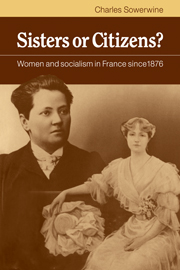Book contents
- Frontmatter
- Contents
- Preface
- Abbreviations of organisations
- Bibliographical abbreviations
- Introduction
- Part I Feminism and socialism 1876–1900
- Part II Origins of the socialist women's movement 1899–1914
- Part III Development and decline of the socialist women's movement 1914–79
- 7 The First World War and socialist women 1914–20
- 8 Reconstruction, decline, and rebirth 1921–79
- Conclusion
- Appendix 1 The Second International and the woman question 1889–1904
- Appendix 2 French socialist women in figures
- Appendix 3 Elisabeth Renaud and the Cambier affair
- Notes
- Bibliography
- Index
8 - Reconstruction, decline, and rebirth 1921–79
Published online by Cambridge University Press: 07 October 2011
- Frontmatter
- Contents
- Preface
- Abbreviations of organisations
- Bibliographical abbreviations
- Introduction
- Part I Feminism and socialism 1876–1900
- Part II Origins of the socialist women's movement 1899–1914
- Part III Development and decline of the socialist women's movement 1914–79
- 7 The First World War and socialist women 1914–20
- 8 Reconstruction, decline, and rebirth 1921–79
- Conclusion
- Appendix 1 The Second International and the woman question 1889–1904
- Appendix 2 French socialist women in figures
- Appendix 3 Elisabeth Renaud and the Cambier affair
- Notes
- Bibliography
- Index
Summary
After the schism, those who refused the conditions posed by the Third International found themselves confronted with the task of rebuilding their ‘old house’, as they called the SFIO. Although they regarded themselves as the inheritors of Jaurès's legacy, in organisational terms the party of Jaurès, the SFIO, had transformed itself into the French communist party, the PCF. Party members who had walked out – ostensibly to maintain the socialist tradition – had actually quit the party. They had to build one anew. Their task was facilitated, however, by the fact that they had with them nearly all the party ‘chiefs’; deputies, bureaucrats, section secretaries, and indeed veterans of the pre-war days in general preferred to rebuild the old republican structure rather than accept the new Bolshevik party.
Most of the pre-war leaders of the GDFS went with them, but the position of women in the new party was not thereby strengthened. Louise Saumoneau had emerged as the most eminent woman of the party, but she had attained her eminence and her seat on the CAP as the representative not of women but of the CRRI. Deprived of her followers, she was named only a deputy member of the new CAP. She did not become a full member until 1927 and then served only three years before resigning in 1930. No other woman sat on the CAP between the two world wars.
- Type
- Chapter
- Information
- Sisters or Citizens?Women and Socialism in France since 1876, pp. 166 - 183Publisher: Cambridge University PressPrint publication year: 1982



